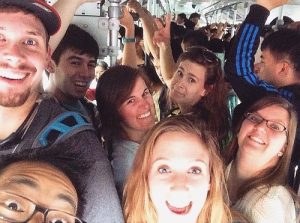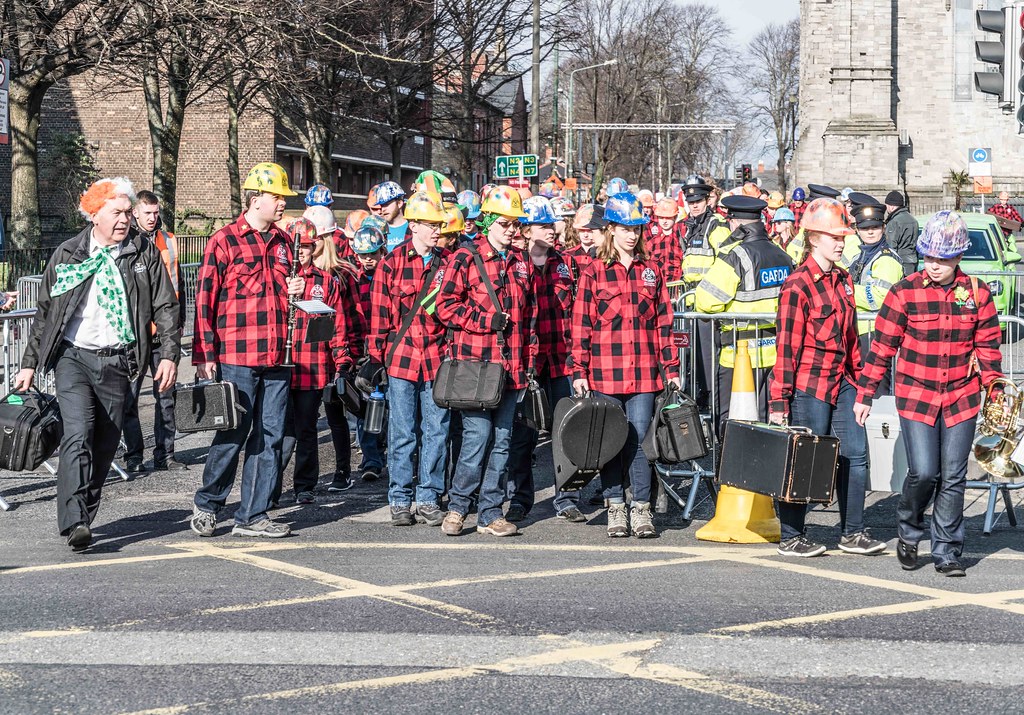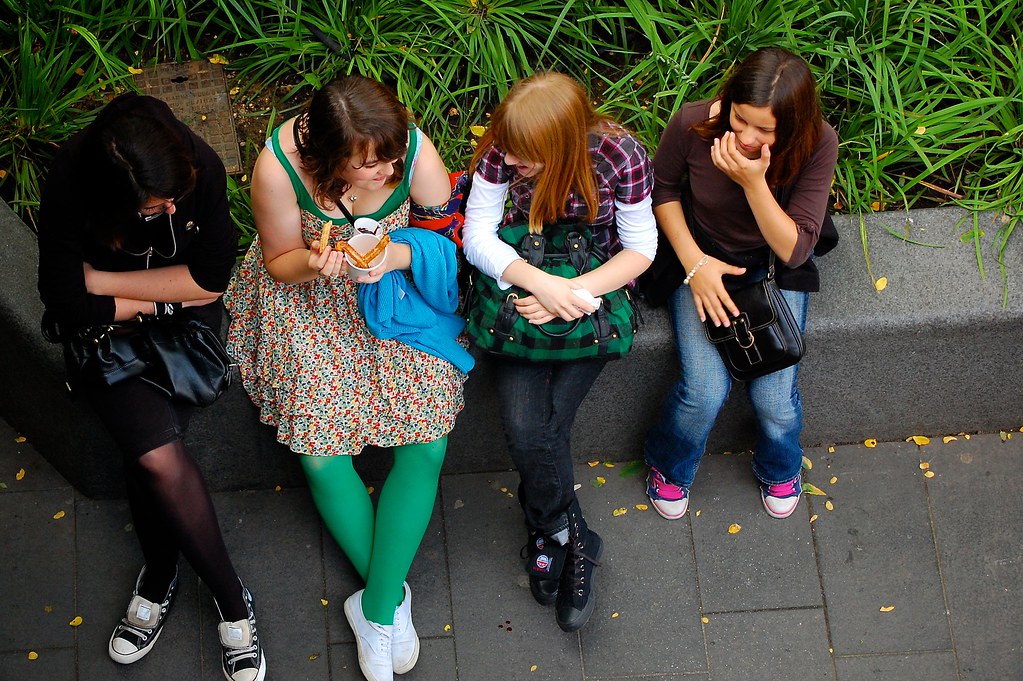Chapter 12: Play and Peer Relationships
Crowds and Cliques
Crowds

Crowds are large groups of adolescents socially connected by a shared image and reputation reputation (Brown & Klute, 2003). Crowd stereotypes are based on peer status, socioeconomic status, residential area, activities, social characteristics, or a combination of attributes (Brown & Klute, 2003; Brown et al., 1994). Because crowd membership reflects external assessments from peers about what group a person “looks like” they belong to, members of a crowd may not even know each other. Some examples of common crowds are jocks, nerds, and band geeks. Crowds provide a social context for identity exploration and self-definition as adolescents internalize or reject their crowd identities (Moran et al., 2017). A single person can belong to more than one crowd if their image matches multiple crowd stereotypes (Brown et al., 1994; Brown & Klute, 2003).
Significance of Crowds Throughout Adolescence
Crowds first emerge in middle or junior high school when early adolescents transition from stable, self-contained classroom peer groups into larger schools with rotating schedules (Daddis, 2010). They are exposed to a more diverse body of peers with less adult guidance. Crowds emerge to group students by stereotypes and structure interactions between students of each type (Brown et al., 1994). With age, adolescents become more conscious of crowd divisions and the social hierarchy (Brown & Klute, 2003).
Relationships can be formed within and outside of a crowd, but the adolescent’s social options for friendship and romance are usually affected by their crowd when they are younger (Brown et al., 1994). Some studies indicate the importance of crowds peaks at age 12 or 13, but by the end of high school, adolescents often feel constrained by impersonal, crowd-derived identities (Brown et al., 1986). Ninth-graders are willing to discriminate against members of other crowds, but twelfth-graders are less likely to do so (Horn, 2003). Adolescent attitudes towards crowds change over time as more value is placed on close friendships and romantic relationships (Horn, 2003).
Crowds and Identity Development

Crowds serve an essential purpose in adolescent identity development. They steer an individual towards certain social norms, teaching them who to avoid, what to believe, and how to behave (Brown et al., 1990; Brown & Larson, 2009; Spears, 2021). An adolescent often defines themselves by the crowd to which they see themselves belonging and adjusts aspects of themselves accordingly (Brown et al., 1994). For example, a member of a “preppy” crowd might be rewarded for dressing in a fashion for which a member of an “emo” crowd would be teased, and vice versa.
Crowds often reinforce the behaviors that initially caused an individual to be labeled part of that crowd. Depending on the behavior, the individual can be positively or negatively influenced (Cross & Fletcher, 2009). These pressures are often linked to the stereotypes members of crowds hold about themselves and members of other crowds (Brown et al., 1994). If an adolescent is in a crowd where the stereotype is to do well academically, they will likely work harder at their studies. However, if they are part of a crowd where academic achievement is frowned upon, they may not do as well in school.
Crowd Membership
Crowd membership is flexible and individuals can be associated with many crowds, not just one. Some adolescents may consciously work to change their crowd affiliations to express different interests or achieve a new social status. Adolescents who frequently change crowd membership (also called “crowd-hopping”) tend to have lower self-esteem, perhaps because they have not yet found a peer group that supports them (Cross & Fletcher, 2009). They likely continue changing crowd membership until they find a fulfilling niche (Brown et al., 1992).
While crowds are structured around stereotypes of their members, real adolescents rarely match those stereotypes exactly. However, so long as they possess a few central characteristics of a crowd, they will be classified as a member of it (Brown, 1990; Cross & Fletcher, 2009). For instance, a student athlete may not neglect their schoolwork like the typical jock stereotype says they would, but if they spend most of their free time playing a sport, they could still be considered a jock by their peers.
Because crowd membership is initially outwardly imposed, an adolescent’s peers can classify them as belonging to a crowd that they do not consider themselves a member of (Brown, 1990). Usually, adolescents embrace their crowd affiliation, using it to define themselves and advertise where they fit in their peer group’s social structure (Brown et al., 1990; Newman & Newman, 2001). However, many crowds are stigmatized, so members of low-status groups may resist or deny their crowd to avoid prejudice (Bodenhousen & Richeson, 2010).
Racial Crowds and Sub-Crowds
The primary, recurring crowd divisions (jocks, geeks, partiers, etc.) have been studied in predominantly white high schools, but they also exist for minority students. In multiracial schools, students seem to divide along racial lines first, then into stereotypical crowds within their race (Brown & Mounts, 1989; Kao, 2000). However, one group may not notice the further divisions in other groups after the first, race-based split (Brown & Mounts, 1989). For instance, black students see themselves as divided into jocks, geeks, emos, stoners, popular kids, and so on, but white students may see them as just one crowd defined solely by race (e.g., “the black kids”). Sometimes crowd membership transcends race, however, and adolescents are just classified as “jocks” or “geeks” regardless of race (Horvat & Lewis, 2003; Tyson et al., 2017). This classification seems to vary and depends heavily on the context of the individual school.
Cliques

A clique is a group of individuals who frequently interact with one another and share similar interests (Dunphy, 2017). A clique is much smaller than a crowd, has specific qualifications for membership, and all members know each other (Dunphy, 2017; Brown et al., 1986). Cliquish behavior often involves shared activities, vernacular, preferences, and mannerisms, which serves to signal who is an outsider of the clique (Hills, 2014).
Cliques are typically closed friend groups that can “ban” members if they do something considered unacceptable, such as talking to someone disliked (Friedkin, 2001; Hills, 2014). Individuals can experience social isolation within their clique if their values and behavior begin to differ from the rest of the group (Closson, 2009). Some cliques tend to isolate themselves as a group and view themselves as superior to others, which can be demonstrated through bullying and other social dominance behaviors (Closson, 2009).
An adolescent may be part of multiple cliques, each forming and functioning independently from one another (Ennett & Bauman, 2000; Friedkin, 2001). However, a clique can also involve a high degree of social commitment which results in an individual having less interaction with other social groups (Hills, 2001). For example, when Cady joined “The Plastics” in Mean Girls, she did not have time to hang out with her original friends anymore. Frequent interaction, whether in-person or online, makes relationships thrive, so a clique may dissolve without it (Lee et al., 2011).
Interacting with cliques is part of normal social development regardless of gender or ethnicity (Dunphy, 2017). Cliques are spaces where adolescents develop their identities, social skills, and attitudes through close interpersonal relationships (Bagwell et al., 2000). Although cliques are most commonly studied during middle childhood and adolescent development, they exist in all age groups (Closson, 2009; Friedkin, 2001; Hills, 2014).
Cliques, Crowds, and Conformity
Video 1. Adolescence, Cliques, Crowds, Conformity discusses the different peer groups and the influence on youth culture.
large groups of adolescents socially connected by a shared image and reputation reputation
a group of individuals who frequently interact with one another and share similar interests

